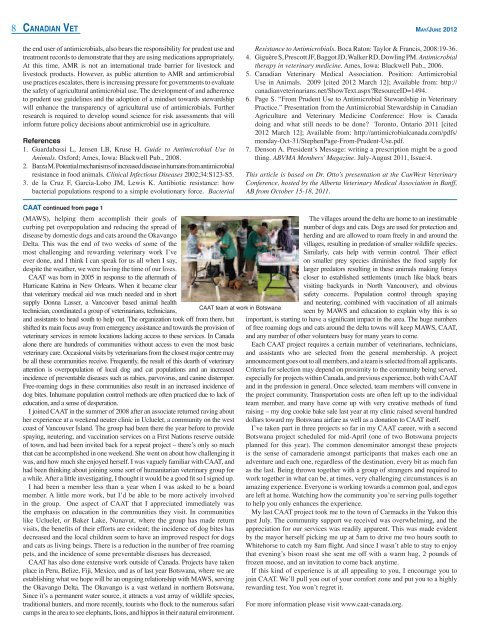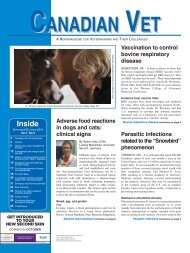canadian vet - K2 Animal Health Publishing
canadian vet - K2 Animal Health Publishing
canadian vet - K2 Animal Health Publishing
You also want an ePaper? Increase the reach of your titles
YUMPU automatically turns print PDFs into web optimized ePapers that Google loves.
8 Canadian Vet<br />
May/June 2012<br />
the end user of antimicrobials, also bears the responsibility for prudent use and<br />
treatment records to demonstrate that they are using medications appropriately.<br />
At this time, AMR is not an international trade barrier for livestock and<br />
livestock products. However, as public attention to AMR and antimicrobial<br />
use practices escalates, there is increasing pressure for governments to evaluate<br />
the safety of agricultural antimicrobial use. The development of and adherence<br />
to prudent use guidelines and the adoption of a mindset towards stewardship<br />
will enhance the transparency of agricultural use of antimicrobials. Further<br />
research is required to develop sound science for risk assessments that will<br />
inform future policy decisions about antimicrobial use in agriculture.<br />
References<br />
1. Guardabassi L, Jensen LB, Kruse H. Guide to Antimicrobial Use in<br />
<strong>Animal</strong>s. Oxford; Ames, Iowa: Blackwell Pub., 2008.<br />
2. Barza M. Potential mechanisms of increased disease in humans from antimicrobial<br />
resistance in food animals. Clinical Infectious Diseases 2002;34:S123-S5.<br />
3. de la Cruz F, Garcia-Lobo JM, Lewis K. Antibiotic resistance: how<br />
bacterial populations respond to a simple evolutionary force. Bacterial<br />
CAAT continued from page 1<br />
(MAWS), helping them accomplish their goals of<br />
curbing pet overpopulation and reducing the spread of<br />
disease by domestic dogs and cats around the Okavango<br />
Delta. This was the end of two weeks of some of the<br />
most challenging and rewarding <strong>vet</strong>erinary work I’ve<br />
ever done, and I think I can speak for us all when I say,<br />
despite the weather, we were having the time of our lives.<br />
CAAT was born in 2005 in response to the aftermath of<br />
Hurricane Katrina in New Orleans. When it became clear<br />
that <strong>vet</strong>erinary medical aid was much needed and in short<br />
supply Donna Lasser, a Vancouver based animal health<br />
technician, coordinated a group of <strong>vet</strong>erinarians, technicians,<br />
and assistants to head south to help out. The organization took off from there, but<br />
shifted its main focus away from emergency assistance and towards the provision of<br />
<strong>vet</strong>erinary services in remote locations lacking access to these services. In Canada<br />
alone there are hundreds of communities without access to even the most basic<br />
<strong>vet</strong>erinary care. Occasional visits by <strong>vet</strong>erinarians from the closest major centre may<br />
be all these communities receive. Frequently, the result of this dearth of <strong>vet</strong>erinary<br />
attention is overpopulation of local dog and cat populations and an increased<br />
incidence of preventable diseases such as rabies, parvovirus, and canine distemper.<br />
Free-roaming dogs in these communities also result in an increased incidence of<br />
dog bites. Inhumane population control methods are often practiced due to lack of<br />
education, and a sense of desperation.<br />
I joined CAAT in the summer of 2008 after an associate returned raving about<br />
her experience at a weekend neuter clinic in Ucluelet, a community on the west<br />
coast of Vancouver Island. The group had been there the year before to provide<br />
spaying, neutering, and vaccination services on a First Nations reserve outside<br />
of town, and had been invited back for a repeat project – there’s only so much<br />
that can be accomplished in one weekend. She went on about how challenging it<br />
was, and how much she enjoyed herself. I was vaguely familiar with CAAT, and<br />
had been thinking about joining some sort of humanitarian <strong>vet</strong>erinary group for<br />
a while. After a little investigating, I thought it would be a good fit so I signed up.<br />
I had been a member less than a year when I was asked to be a board<br />
member. A little more work, but I’d be able to be more actively involved<br />
in the group. One aspect of CAAT that I appreciated immediately was<br />
the emphasis on education in the communities they visit. In communities<br />
like Ucluelet, or Baker Lake, Nunavut, where the group has made return<br />
visits, the benefits of their efforts are evident; the incidence of dog bites has<br />
decreased and the local children seem to have an improved respect for dogs<br />
and cats as living beings. There is a reduction in the number of free roaming<br />
pets, and the incidence of some preventable diseases has decreased.<br />
CAAT has also done extensive work outside of Canada. Projects have taken<br />
place in Peru, Belize, Fiji, Mexico, and as of last year Botswana, where we are<br />
establishing what we hope will be an ongoing relationship with MAWS, serving<br />
the Okavango Delta. The Okavango is a vast wetland in northern Botswana.<br />
Since it’s a permanent water source, it attracts a vast array of wildlife species,<br />
traditional hunters, and more recently, tourists who flock to the numerous safari<br />
camps in the area to see elephants, lions, and hippos in their natural environment.<br />
Resistance to Antimicrobials. Boca Raton: Taylor & Francis, 2008:19-36.<br />
4. Giguère S, Prescott JF, Baggot JD, Walker RD, Dowling PM. Antimicrobial<br />
therapy in <strong>vet</strong>erinary medicine. Ames, Iowa: Blackwell Pub., 2006.<br />
5. Canadian Veterinary Medical Association. Position: Antimicrobial<br />
Use in <strong>Animal</strong>s. 2009 [cited 2012 March 12]; Available from: http://<br />
<strong>canadian</strong><strong>vet</strong>erinarians.net/ShowText.aspx?ResourceID=1494.<br />
6. Page S. “From Prudent Use to Antimicrobial Stewardship in Veterinary<br />
Practice.” Presentation from the Antimicrobial Stewardship in Canadian<br />
Agriculture and Veterinary Medicine Conference: How is Canada<br />
doing and what still needs to be done? Toronto, Ontario 2011 [cited<br />
2012 March 12]; Available from: http://antimicrobialcanada.com/pdfs/<br />
monday-Oct-31/StephenPage-From-Prudent-Use.pdf.<br />
7. Denson A. President’s Message: writing a prescription might be a good<br />
thing. ABVMA Members’ Magazine. July-August 2011, Issue:4.<br />
This article is based on Dr. Otto’s presentation at the CanWest Veterinary<br />
Conference, hosted by the Alberta Veterinary Medical Association in Banff,<br />
AB from October 15-18, 2011.<br />
The villages around the delta are home to an inestimable<br />
number of dogs and cats. Dogs are used for protection and<br />
herding and are allowed to roam freely in and around the<br />
villages, resulting in predation of smaller wildlife species.<br />
Similarly, cats help with vermin control. Their effect<br />
on smaller prey species diminishes the food supply for<br />
larger predators resulting in these animals making forays<br />
closer to established settlements (much like black bears<br />
visiting backyards in North Vancouver), and obvious<br />
safety concerns. Population control through spaying<br />
and neutering, combined with vaccination of all animals<br />
seen by MAWS and education to explain why this is so<br />
important, is starting to have a significant impact in the area. The huge numbers<br />
of free roaming dogs and cats around the delta towns will keep MAWS, CAAT,<br />
and any number of other volunteers busy for many years to come.<br />
Each CAAT project requires a certain number of <strong>vet</strong>erinarians, technicians,<br />
and assistants who are selected from the general membership. A project<br />
announcement goes out to all members, and a team is selected from all applicants.<br />
Criteria for selection may depend on proximity to the community being served,<br />
especially for projects within Canada, and previous experience, both with CAAT<br />
and in the profession in general. Once selected, team members will convene in<br />
the project community. Transportation costs are often left up to the individual<br />
team member, and many have come up with very creative methods of fund<br />
raising – my dog cookie bake sale last year at my clinic raised several hundred<br />
dollars toward my Botswana airfare as well as a donation to CAAT itself.<br />
I’ve taken part in three projects so far in my CAAT career, with a second<br />
Botswana project scheduled for mid-April (one of two Botswana projects<br />
planned for this year). The common denominator amongst these projects<br />
is the sense of camaraderie amongst participants that makes each one an<br />
adventure and each one, regardless of the destination, every bit as much fun<br />
as the last. Being thrown together with a group of strangers and required to<br />
work together in what can be, at times, very challenging circumstances is an<br />
amazing experience. Everyone is working towards a common goal, and egos<br />
are left at home. Watching how the community you’re serving pulls together<br />
to help you only enhances the experience.<br />
My last CAAT project took me to the town of Carmacks in the Yukon this<br />
past July. The community support we received was overwhelming, and the<br />
appreciation for our services was readily apparent. This was made evident<br />
by the mayor herself picking me up at 5am to drive me two hours south to<br />
Whitehorse to catch my 8am flight. And since I wasn’t able to stay to enjoy<br />
that evening’s bison roast she sent me off with a warm hug, 2 pounds of<br />
frozen moose, and an invitation to come back anytime.<br />
If this kind of experience is at all appealing to you, I encourage you to<br />
join CAAT. We’ll pull you out of your comfort zone and put you to a highly<br />
rewarding test. You won’t regret it.<br />
For more information please visit www.caat-canada.org.





